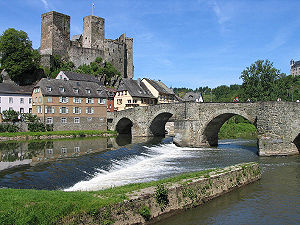|
Runkel
  Runkel is a town on the river Lahn in Limburg-Weilburg district in Hesse, Germany. Geography LocationRunkel lies in the Lahn Valley on both sides of the river between the Westerwald and the Taunus, some eight kilometres east of Limburg. Neighbouring communitiesRunkel borders in the north on the community of Beselich and the town of Weilburg, in the east on the communities of Weinbach and Villmar and in the south and west on the town of Limburg. Constituent communitiesThe town consists of 9 Stadtteile.
History  The town's first documentary mention came in 1159 in an enfeoffment document in which a nobleman named Siegfried von Runkel had his name appear as a witness. It is believed that this Siegfried was the one who built Runkel Castle. In 1191 Siegfried married a countess of Katzenelnbogen. This high noble family forced Dietrich of Runkel to open his castles Runkel and Dehrn. No later than 1230, the castle had a chapel, thereby giving Runkel its first church building. In 1288, after years of family disputes, the Lords of Runkel and those of Westerburg sundered into two lines. In 1440, building work began on the Lahn bridge, but owing to the rift between the Runkels and the Westerburgs, the work took until 1448. In 1447 Count Philipp of Katzenelnbogen was the liege lord.[3] In 1543, Count Johann IV of Wied had Philipp Melanchthon as a guest at Runkel Castle. In 1568, the Reformation was introduced. In 1622, there was yet another family rift when Count Hermann II at Wied drove his younger brother Philipp Ludwig out of the leadership and indeed from the castle. In 1634, the town and the castle were largely destroyed by Count Johann Ludwig Hektor von Isolani's troops in the Thirty Years' War. In 1649, the castle's dwelling buildings were newly built as a residential castle. In the early 18th century, continued French invasions combined with a record cold winter led many people from the Palatinate, including Runkel an Lahn, to emigrate down the Rhine River, then to England in 1709. There were so many refugees from the German Palatine region that the English government set up a tent city for the winter outside the London walls. In 1710 ten English ships carried nearly 3,000 Germans to the colony of New York. The people worked off their passage in camps on the Hudson River. In 1723 and later they were finally allowed to acquire land in New York's Mohawk Valley, where they established towns such as German Flatts and Palatine Bridge, New York. In 1791, Friedrich Ludwig, the last of the Wied-Runkel line, was made a prince. In 1796, fighting in Runkel's streets broke out as troops of the Landgrave of Hesse-Darmstadt drove French revolutionary occupying soldiers out of town. In 1806, the Runkel holdings on the Lahn's right bank, and thereby the part of the town of Runkel lying there, passed to the Duchy of Berg. In 1824, the Wied-Runkel line died out with Prince Friedrich Ludwig's death, putting the lordly domain, along with the town of Runkel, in Wied-Neuwied's hands. Winegrowing is known to have been practised in Runkel by 1270. In 1929, however, it was given up after the phylloxera infestation and a cold winter. In the end, the vinicultural area amounted to 35 hectares. In 1860, the first savings and loan association (Sparkasse) in Runkel was founded under the name Vorschuss-Verein (“Credit Club”). Since 1914 there has been a central water supply in the town. In the course of administrative reform in Hesse, the formerly autonomous communities of Steeden, Ennerich and Schadeck merged on 1 December 1970, as did likewise Arfurt, Eschenau, Hofen and Wirbelau on 31 December 1970, with the town of Runkel. The community of Dehrn was only amalgamated on 1 July 1974 by state law. The outlying centre with the earliest documentary mention is Ennerich, which can prove its existence in 790. PoliticsTown council
The municipal election held on 26 March 2006 yielded the following results:
Elections in 2016: [4]
Culture and sightseeingBuildings

Economy and infrastructureTransportThe town is linked to the long-distance road network through the Limburg-Süd interchange on the A 3 (Cologne–Frankfurt), 7 km away. Runkel station and Arfurt (Lahn) station both lie within the municipality on the Lahntal railway (Koblenz-Limburg-Runkel-Wetzlar-Gießen) at which only regional trains stop. The town lies within the Rhein-Main-Verkehrsverbund area. EducationIn Runkel is found the Johann-Christian-Senckenberg-Schule. This is a primary school, Hauptschule and Realschule with a Förderstufe (a programme for streaming students into the secondary school best suited to their needs). It was named after the German physician and endower Johann Christian Senckenberg. Further primary schools are found in Arfurt, Dehrn, Steeden and Runkel. Students from Runkel also attend the Gymnasien in Limburg and Weilburg. Public institutions
External linksWikimedia Commons has media related to Runkel.
References
|
||||||||||||||||||||||||||||||||||||||||||||||||||||||||||||||||||||||||||||||||||||||||||||||||||||||||||||||||||||||||||||||||||||



